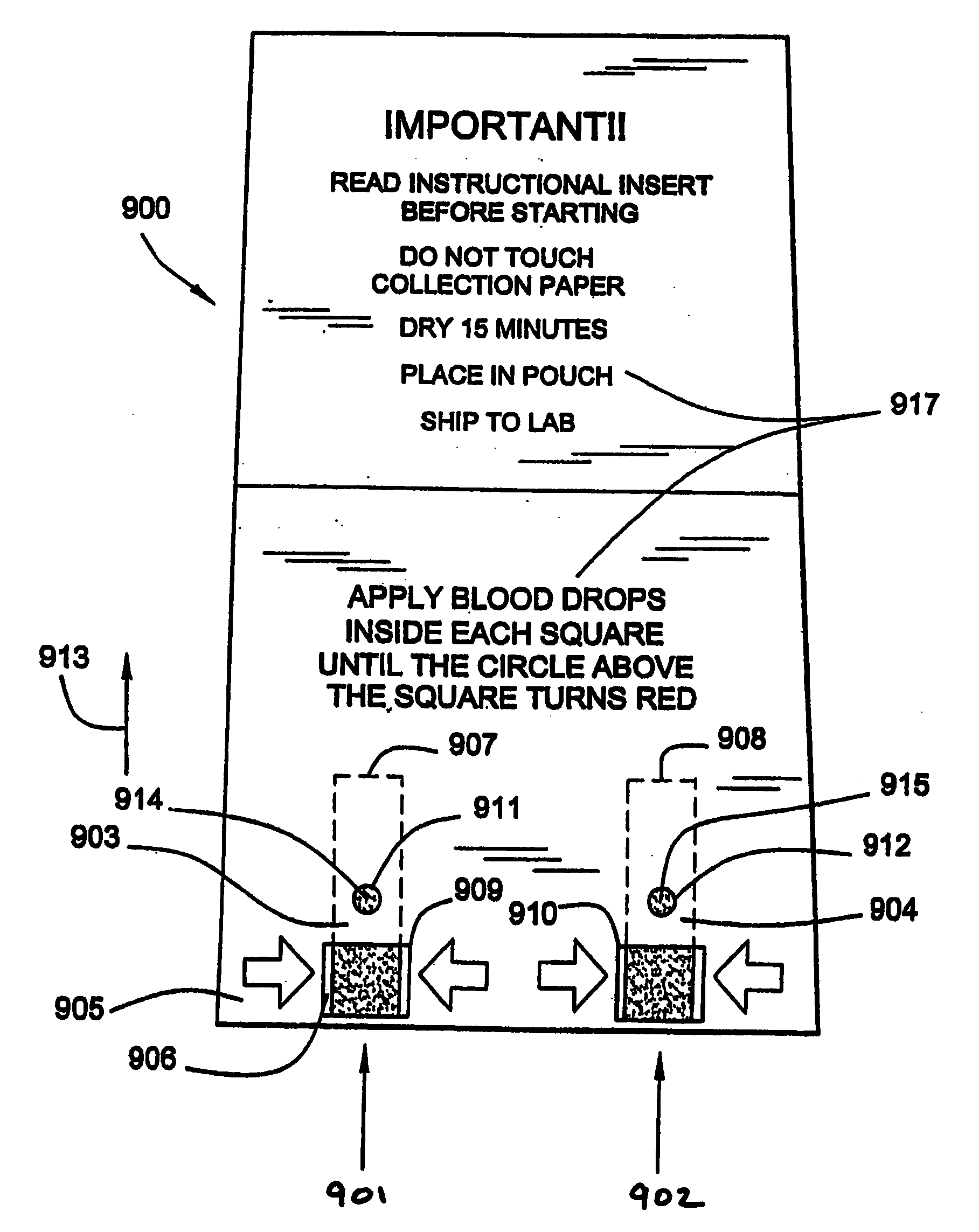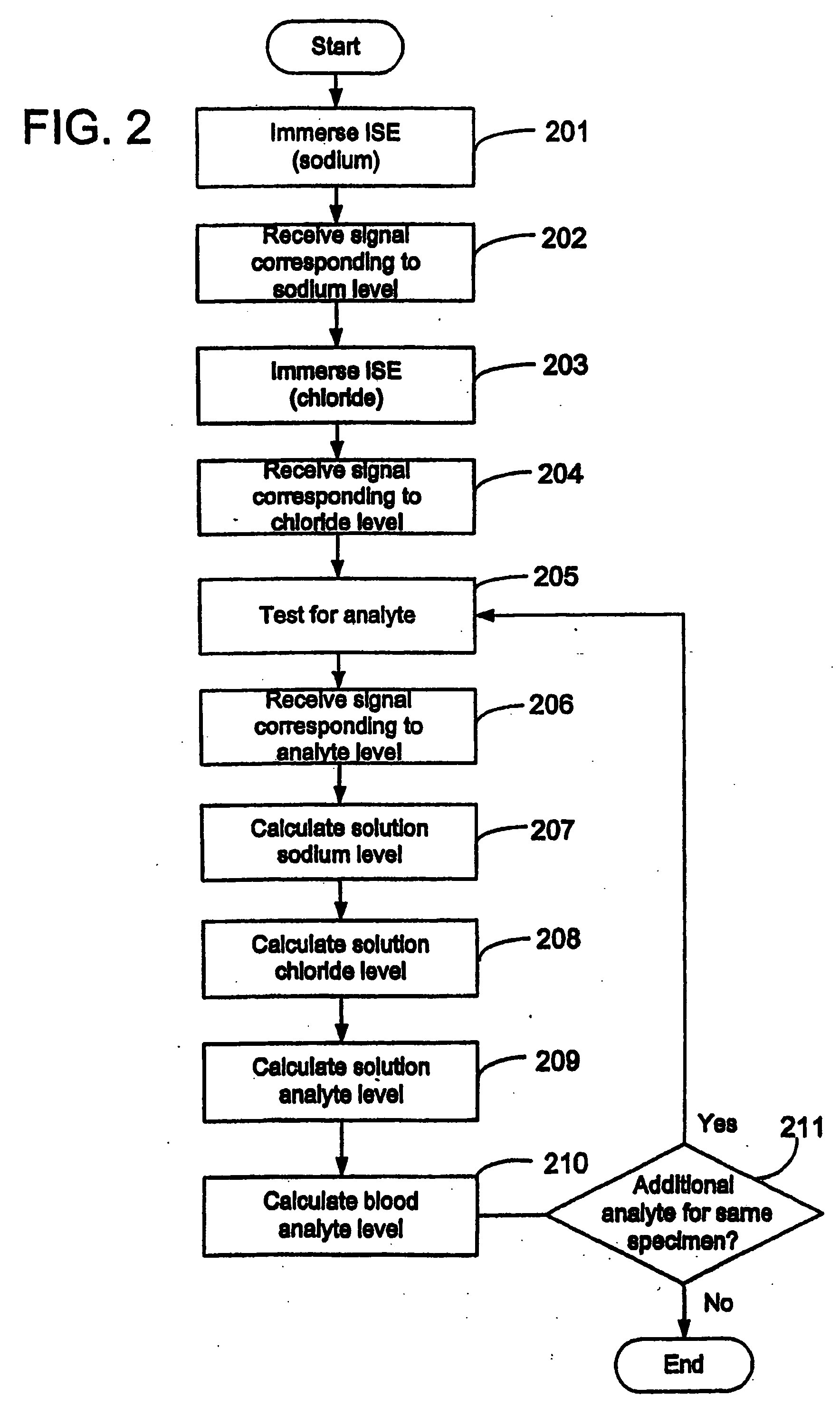Quantitative analysis of a biological sample of unknown quantity
a biological sample and quantitative analysis technology, applied in the field of quantitative testing, can solve the problems of difficult to gauge difficult to know to certainty whether the spot card is present, and difficult to quantify the amount of blood or serum present in the blood or serum spot card
- Summary
- Abstract
- Description
- Claims
- Application Information
AI Technical Summary
Problems solved by technology
Method used
Image
Examples
example 1
[0076] This example demonstrates the performance of the invention in the measurement of total cholesterol.
[0077] Fifteen patients were used to obtain blood specimens (micro-serum specimens) via venal puncture. Serum from each specimen was spotted and dried on filter paper with applied volumes ranging from approximately 8 to 16 μl. The number of spots for each blood specimen is listed in the column “No.” in the table below. Each spot was eluted and measured for cholesterol and sodium. For each specimen for each patient, the normalized cholesterol level was calculated based on the level of a measured analyte in the fluid (cholesterol) and a normalizing analyte (sodium). The normalized cholesterol level was obtained according to the present invention using linear regression techniques to yield the following function: Normalized Cholesterol=Measured Cholesterol / ((−0.003306)+0.9781×(Measured Sodium / 13)), where 139 (mEq / L) is the population mean for sodium. The regression was calculated ...
example 2
[0079] This example demonstrates the performance of the invention in the measurement of HDL.
[0080] The same dried spots from the same fifteen patients in Example 1 were used to obtain a measured value for HDL. The normalized HDL level was obtained according to the present invention using linear regression techniques yielding the following function:
Normalized HDL=HDL / (0.0158+1.060×(Sodium / 139)). The following data was measured or calculated in the same manner as in Example 1.
Mean SerumMean NormalizedNormalizedPatientNo.HDLHDLHDL CV %II1445.7747.032.35A1146.0547.772.17Jo1147.4048.502.12Ja1248.8753.222.23JJ1449.0748.151.68Gr1249.6452.451.62Mi1259.9658.951.69Br1057.2055.832.66Ed1271.0071.090.92Kt1273.0872.461.53TT1376.1675.772.27Ca1278.0175.931.50Bb1178.7773.351.99Ma1187.8484.750.94Tr1191.1586.421.46
[0081] A comparative linear regression was generated for the data points collected in this Example. The linear fit followed the following equation:
Mean Normalized HDL=8.15+0.87×Mean Seru...
example 3
[0082] This example demonstrates the performance of the invention in the measurement of triglycerides (TG).
[0083] The same dried spots from the same fifteen patients in Example 1 were used to obtain a measured value for TG. The normalized TG level was obtained according to the present invention using linear regression techniques yielding the following function:
Normalized TG=TG / ((−0.0136)+0.9307×(Sodium / 139)). The following data was measured or calculated in the same manner as in Example 1.
Mean NormalizedNormalizedPatientNo.Mean Serum TGTGTG CV %Ca1237.6338.761.95Bb1146.8648.551.75A1148.7550.162.73Ja1249.6849.943.31Kt1252.1548.191.32Br1055.0056.564.14Ma1156.0556.402.03II1459.0960.886.22Ed1262.9161.651.25Tr1166.6967.661.63TT1368.7672.1413.37Mi1271.8472.631.62Jo11109.28107.102.27JJ14117.31112.245.03Gr12139.47136.742.13
[0084] A comparative linear regression was generated for the data points collected in this Example. The linear fit followed the following equation:
Mean Normalized TG=...
PUM
| Property | Measurement | Unit |
|---|---|---|
| pore size | aaaaa | aaaaa |
| volumes | aaaaa | aaaaa |
| TG | aaaaa | aaaaa |
Abstract
Description
Claims
Application Information
 Login to View More
Login to View More - R&D
- Intellectual Property
- Life Sciences
- Materials
- Tech Scout
- Unparalleled Data Quality
- Higher Quality Content
- 60% Fewer Hallucinations
Browse by: Latest US Patents, China's latest patents, Technical Efficacy Thesaurus, Application Domain, Technology Topic, Popular Technical Reports.
© 2025 PatSnap. All rights reserved.Legal|Privacy policy|Modern Slavery Act Transparency Statement|Sitemap|About US| Contact US: help@patsnap.com



